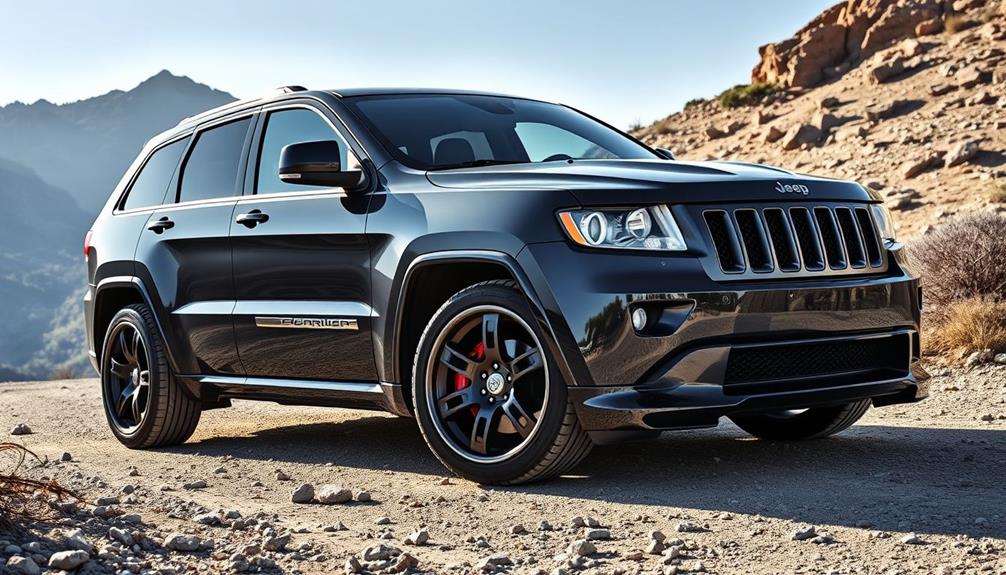Tuning your 2006 Toyota Scion xB can really elevate its performance. Start by targeting around 200 horsepower with upgrades like a Greddy supercharger or a Gude head package. Basic modifications can take you to a solid 107 wheel horsepower. Don't forget to enhance your handling with lightweight wheels and performance tires for better traction. Regular maintenance will keep your engine running smoothly as you push its limits. With the right modifications and community insights, your xB can truly shine. There's plenty more to explore on maximizing your ride's potential and ensuring an exciting driving experience.
Key Takeaways
- Consider a Greddy supercharger and Gude head package for significant horsepower gains and improved engine airflow in your Scion xB.
- Lightweight wheels and performance tires enhance acceleration, handling, and grip, maximizing the driving experience of your modified xB.
- Regular maintenance and tuning are essential to address potential tire hop and transmission issues that may arise from performance upgrades.
- Explore community forums for insights on successful modifications and engine swaps, ensuring informed decisions on enhancements.
- Prioritize engine reliability by reinforcing internal components when pursuing higher horsepower outputs beyond stock specifications.
Performance Upgrade Goals
When it comes to performance upgrade goals for your 2006 Toyota Scion xB, aiming for around 200 horsepower is a popular target among enthusiasts. Many owners start with realistic expectations, often seeing gains between 100-150 horsepower with specific setups.
To reach those ambitious goals, you might consider investing in a full Gude head package. This extensive upgrade, valued at $2,200, includes porting, polishing, custom cams, and bigger valves that can greatly boost your engine's output.
Another effective option is incorporating a Greddy supercharger with e-manage. Priced at around $3,200, this modification can help you achieve considerable power gains, inching you closer to that 200-horsepower mark.
If you're looking for more aggressive performance upgrades, basic modifications or bolt-on turbo kits typically fall within the $5,000 to $6,000 range. For a full engine build to achieve those notable horsepower increases, you might be looking at around $10,000.
Achieving remarkable performance milestones, such as 107 wheel horsepower with bolt-ons or a dyno pull of 154 hp at the wheels, can truly enhance the driving experience of your Scion xB.
Cost of Modifications

Achieving your performance upgrade goals for the 2006 Scion xB involves understanding the costs associated with various modifications. The cost of modifications can vary widely based on your goals. If you're looking for a full engine build to greatly boost horsepower, prepare to invest around $10,000.
On a tighter budget, you might spend $5,000 to $6,000 for basic upgrades or a bolt-on turbo kit. Opting for used parts, such as superchargers or turbos, can save you about $1,000 compared to buying new.
For a solid foundation, consider a fully built and balanced short block with aftermarket rods and pistons, which will set you back roughly $2,800. If you want additional performance, a Greddy supercharger paired with an e-manage costs around $3,200, providing a considerable power increase.
Keep in mind that long-term maintenance costs can rise as you make more extensive modifications, so factor that into your budgeting. By understanding the cost of modifications, you can make informed decisions that align with your performance objectives while keeping your financial goals in check.
Essential Engine Modifications
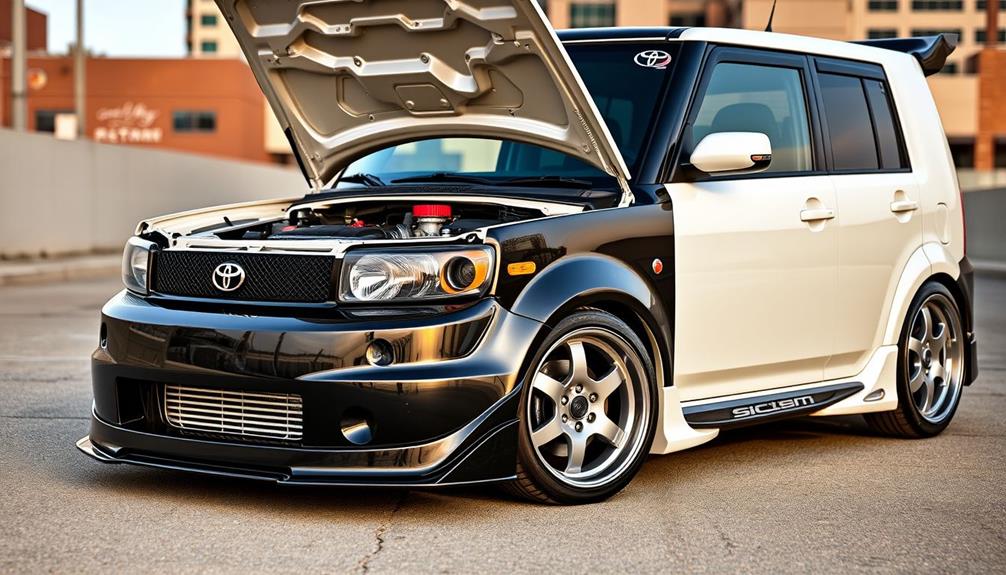
When it comes to boosting your Scion xB's performance, you'll want to focus on key engine modifications that really make a difference.
Consider upgrades like a Greddy supercharger or a full Gude head package to maximize airflow and horsepower.
If you're feeling ambitious, an engine swap could also provide the power boost you're seeking, but be ready for the complexities involved.
Performance Enhancing Upgrades
To access the full potential of your 2006 Toyota Scion xB, investing in key performance-enhancing upgrades is essential.
One of the most effective options is the full Gude head package, priced at $2200, which boosts airflow and performance through features like port and polish, custom cams, and larger valves.
For a substantial power increase, consider the Greddy supercharger, available for $3200, paired with an e-manage system that can elevate your output to around 175 horsepower at the wheels.
You can also enhance your vehicle's performance with a well-rounded upgrade package, including a Greddy header, Fidanza flywheel, and ACT stage 4 clutch, all for over $700.
These components contribute to better throttle response and overall efficiency.
If you're looking for a simpler path, basic bolt-on modifications can help you achieve a remarkable 107 wheel horsepower, setting the stage for future upgrades.
Engine Swap Considerations
Considering an engine swap for your 2006 Scion xB can dramatically enhance its performance, especially if you're aiming to break free from the limitations of the stock engine. One popular choice is the xD motor swap, which boosts your power from the stock 120 hp, providing a noticeable increase in acceleration and overall responsiveness.
If you're looking for something more aggressive, the Chevy V8 swap, though less common, offers significant power gains and an exhilarating driving experience.
However, before diving into engine swaps for the 2006 Scion xB, it's essential to reinforce internal engine components. This guarantees your new setup can handle the increased power levels without compromising reliability.
Additionally, pay close attention to drivetrain layout—whether you opt for rear or all-wheel drive—since this decision greatly impacts your vehicle's handling and performance post-swap.
Don't forget to research and verify successful swap stories within the Scion community. Learning from others' experiences can provide valuable insights, helping you navigate the complexities of your engine swap and achieve the best possible outcome.
Common Performance Challenges
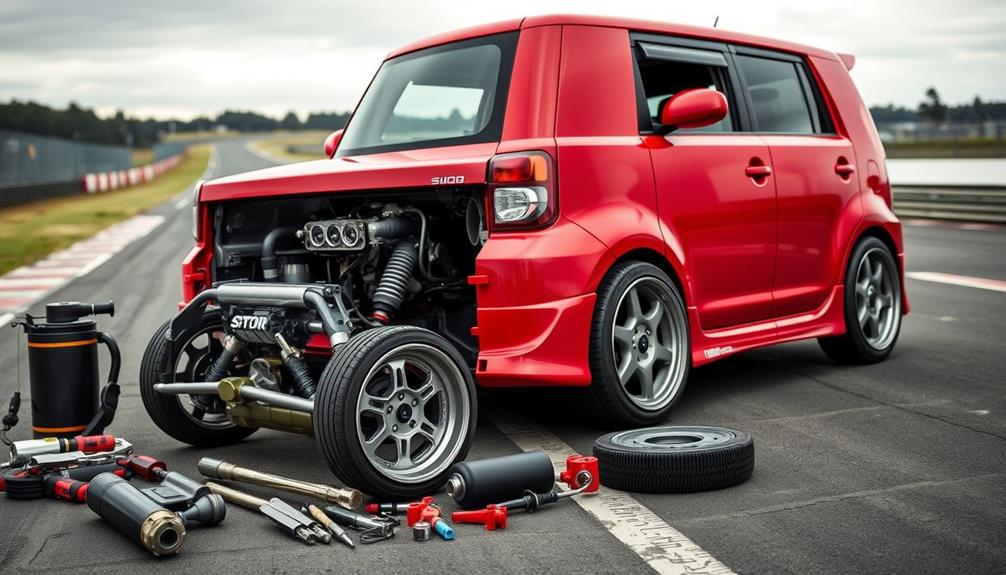
When tuning your Toyota Scion XB, you might encounter common performance challenges like tire hop and transmission issues that can limit your gains. To address these performance challenges, consider upgrading your suspension and tires to reduce tire hop and improve traction. Additionally, performing regular maintenance on your transmission and possibly upgrading it can help prevent transmission issues. When exploring classic Toyota Supra tuning, you can draw inspiration from its high-performance history to enhance the overall performance of your Scion XB. By incorporating tried and true tuning techniques from the Supra, you can unlock the full potential of your vehicle. Moreover, you can also look into Toyota Corolla 2021 tuning techniques to further enhance your Scion XB’s performance. The Corolla’s advancements in engine tuning and efficiency-focused upgrades offer valuable insights that can be applied to your Scion XB, resulting in smoother power delivery and fuel optimization. By combining approaches used in both the Supra and Corolla, you’ll be able to fine-tune your Scion XB for both improved reliability and enhanced performance on the road.
It's essential to guarantee your engine remains reliable, especially if you're pushing for more power.
Addressing these concerns will help you maximize your modifications and enhance your overall driving experience.
Tire Hop Issues
Experiencing tire hop is a common hurdle for many Scion xB enthusiasts who've modified their vehicles. This issue often arises from inadequate traction, which can severely hinder your acceleration performance. If you're looking to achieve smoother launches and improve grip, tackling tire hop is vital.
With the right tuning and traction enhancements, you could see quarter-mile times dropping to around 14 seconds. Investing in a diversified retirement portfolio, including options like gold IRAs, can also provide long-term financial stability, which is vital for any car enthusiast.
Upgrading to performance tires can be a game-changer. Stock tires may not provide the grip needed for higher horsepower setups, so investing in tires designed for better traction can greatly reduce tire hop.
Additionally, consider suspension modifications, like lowering your xB, to enhance weight distribution. However, keep in mind that this requires careful tuning to avoid front-end scraping.
Regular maintenance and consistent tuning are essential as well. These practices will help minimize tire hop, ensuring your modifications boost performance without compromising reliability.
Transmission Performance Challenges
Transmission performance challenges aren't the only factors to take into account when tuning your Scion xB; understanding how to properly maintain your vehicle can lead to enhanced performance.
Regular maintenance can help prevent issues such as potential side effects that may arise from modifications if not carefully managed. Tire hop isn't the only performance challenge you might face with your Scion xB; transmission issues can also considerably affect your driving experience.
When tackling transmission performance challenges, you should be aware of the following common issues:
- Slipping Gears: This can lead to a loss of power when you need it most, especially during acceleration.
- Difficulty Shifting: If you struggle to shift smoothly, it can ruin your driving enjoyment and performance.
- Inadequate Power Handling: Upgrades might enhance your engine's output, but if your transmission can't handle it, you'll negate those benefits.
- Poor Drivetrain Layout Understanding: Not knowing how your xB's drivetrain affects power delivery can hinder performance improvement.
To maximize your Scion xB's potential, addressing these transmission performance challenges is crucial.
Regular tuning and maintenance will help sustain your performance gains and guarantee your transmission can cope with any modifications.
Engine Reliability Concerns
Engine reliability is essential for maximizing your Scion xB's performance, especially when you consider the potential drawbacks of excessive modifications. Pushing horsepower levels beyond the factory specifications of around 120 hp can compromise engine reliability. The design weaknesses in lower engine components may require reinforcement if you're planning to turbocharge or supercharge your ride.
Consistent tuning and maintenance are vital for sustaining any performance gains you achieve. Neglecting regular maintenance can lead to engine wear and potential failure, which is a risk you want to avoid.
Additionally, common performance challenges like tire hop and transmission issues can hinder the effectiveness of your engine mods, resulting in inconsistent power delivery.
If you aim for higher performance benchmarks, such as hitting a 14-second quarter-mile time, you'll need to carefully consider your drivetrain layout and the integrity of your components. Addressing these engine reliability concerns upfront can save you from costly repairs down the line and keep your Scion xB performing at its best.
Community Modding Insights
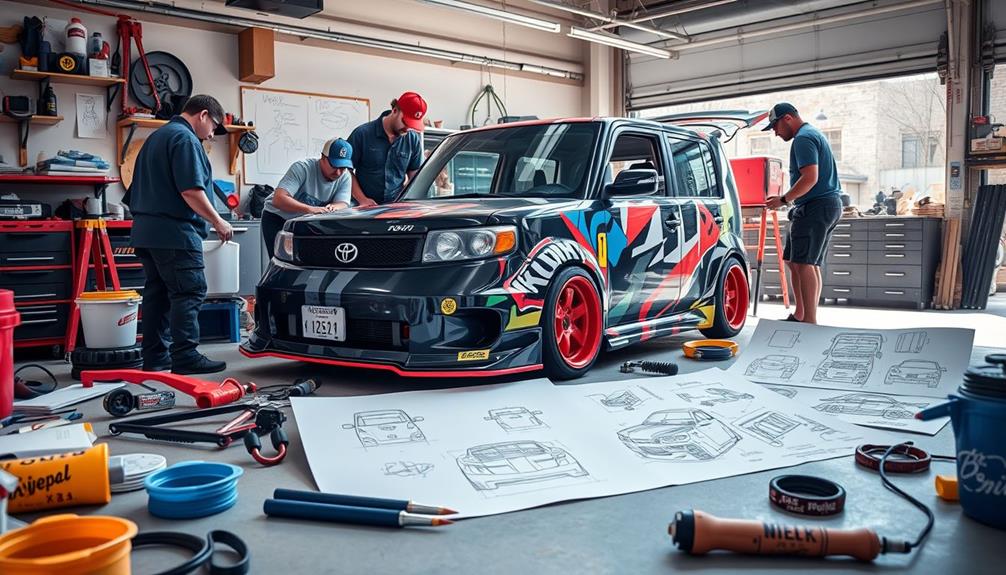
In the vibrant world of 2006 Scion xB tuning, online forums stand out as invaluable platforms for enthusiasts to connect and share their modding journeys.
These communities provide essential community modding insights that can help you navigate your tuning experience more effectively. Here are four key aspects to keep in mind:
- Personal Experiences: Learn from others' successes and challenges, which can save you time and money. Engaging in discussions can also enhance your understanding of common financial terms that could relate to budgeting for your modifications.
- Subjective Goals: Understand that performance goals are personal; modifications should align with your driving preferences, not just horsepower numbers.
- Effective Upgrades: Seasoned modders often recommend lightweight wheels and intake modifications as great first steps for enhancing performance.
- Power Gains: For more significant upgrades, consider engine swaps or higher-performance models, as stock xB engines have limitations.
Engaging with the modding community fosters a supportive environment, making it easier for you to make informed decisions about your upgrades.
You'll find encouragement and valuable advice that can demystify the complexities of performance tuning, ensuring your 2006 Scion xB reflects your unique style and preferences.
Wheel and Tire Improvements

Upgrading your Scion xB's wheels and tires can dramatically improve both performance and style.
Lightweight wheels reduce unsprung weight, enhancing acceleration and handling, while new tires boost traction.
Plus, a fresh set of wheels gives your ride a sleek, eye-catching look that sets it apart on the road.
Weight Reduction Benefits
How can you enhance your 2006 Scion xB's performance while making it look better? One effective way is through weight reduction benefits that come from upgrading your wheels and tires.
Here are four key advantages you'll notice:
- Improved Acceleration: Lightweight Work Meister wheels reduce unsprung weight, allowing for quicker starts and better acceleration.
- Enhanced Handling: Replacing stock 15-inch wheels with lighter options like Konig Decagrams improves your xB's handling, making it more responsive in turns.
- Better Grip: Pairing these lightweight wheels with Nitto Neogen tires (205/50/15) boosts grip, further enhancing your driving experience.
- Increased Fuel Efficiency: A lighter setup means your engine uses less energy to overcome inertia, leading to better fuel economy.
With these upgrades, you'll not only achieve a more agile power-to-weight ratio but also enjoy a more dynamic driving experience.
Aesthetic Enhancements
Transforming the look of your 2006 Scion xB can be just as rewarding as enhancing its performance. One effective way to achieve this is by upgrading to lightweight 15-inch Konig Decagrams wheels paired with Nitto Neogen tires (205/50/15).
This combination not only enhances the aesthetics but also considerably reduces unsprung weight, improving handling and responsiveness. The sleek design of these wheels, especially when used with spacers, gives your xB a flush, aggressive appearance that far surpasses the stock hubcaps.
To further elevate the aesthetic enhancements, consider lowering your vehicle with CX Racing coilovers. This modification not only enhances stability and handling but also creates a sportier stance that beautifully complements the new wheel design.
The overall effect of lightweight wheels and a lowered stance is transformative, making your boxy compact stand out on the road.
Performance Impact
The aesthetic improvements made with lightweight wheels and a lowered stance directly influence the performance of your 2006 Scion xB. Upgrading to lightweight wheels, like Konig Decagrams, reduces unsprung weight, enhancing acceleration and overall handling.
Coupling these with Nitto Neogen tires (205/50/15) improves grip and traction, leading to better cornering stability and braking performance. Here's how these changes create a significant performance impact:
- Reduced Unsprung Weight: Lightweight wheels boost responsiveness and handling.
- Improved Grip: Performance tires enhance traction, increasing stability around corners.
- Lowered Stance: Lowering the vehicle by three inches lowers the center of gravity, decreasing body roll during aggressive driving.
- Proper Alignment: Ensuring accurate alignment post-upgrades maximizes performance gains and prevents uneven tire wear.
This combination not only maximizes your xB's agility but also elevates its visual appeal with a flush look through spacers.
Steering Wheel Enhancements
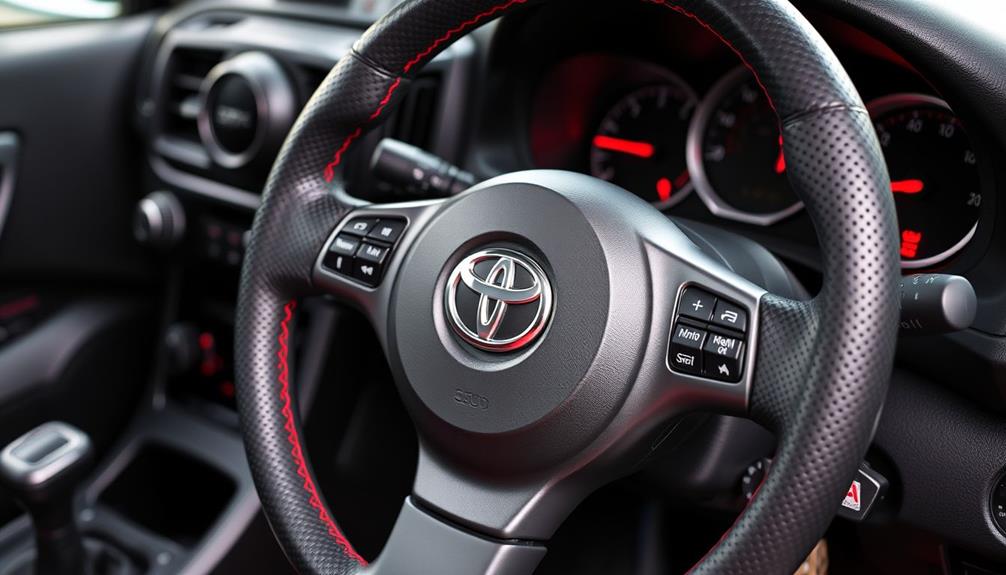
Upgrading your steering wheel can markedly enhance both the grip and aesthetic appeal of your 2006 Scion xB's interior.
Consider swapping in a Toyota Matrix or Corolla steering wheel; this upgrade not only boosts grip but also maintains airbag functionality without triggering any warning lights. You'll enjoy a more premium feel and improved comfort, making every drive more enjoyable.
Another great option for steering wheel enhancements is adding a leather wrap. This DIY project transforms the interior appearance while allowing you to personalize your ride, giving it that unique touch.
A well-designed steering wheel can notably contribute to better handling feedback, making your driving experience more responsive as you tweak other components.
Moreover, a visually appealing steering wheel complements any other interior enhancements you've made, creating a cohesive and upgraded look for your Scion xB.
With these steering wheel enhancements, you're not just improving aesthetics; you're also elevating your entire driving experience.
Unique Mirror Upgrades

After enhancing your steering wheel, it's time to contemplate how unique mirror upgrades can further elevate your 2006 Scion xB's style.
Upgrading to aftermarket mirrors can make a significant difference in your vehicle's appearance, giving it a distinctive edge. Here's why you should consider unique mirror upgrades:
- Distinctive Look: CX Racing mirrors offer a unique design that pays homage to the mini trucking scene.
- Affordable Enhancement: You can snag these mirrors for about $40 on eBay, making them an easy upgrade.
- Visual Transformation: These mirrors drastically change your xB's profile compared to stock options.
- DIY Installation: You can install these mirrors yourself, allowing for a personal touch while ensuring airbag functionality remains intact.
Intake System Adjustments
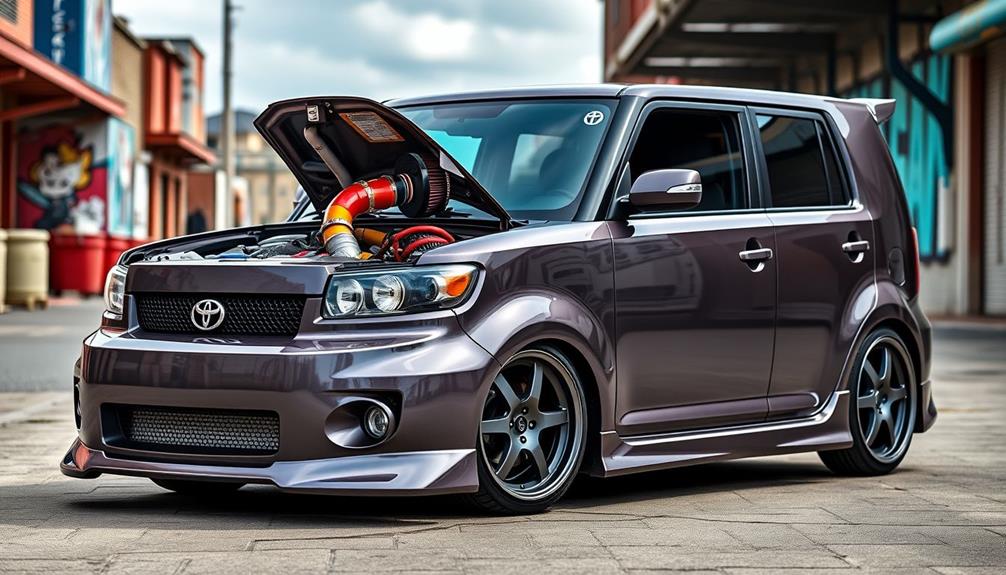
While enhancing your 2006 Scion xB's performance, consider making intake system adjustments that can dramatically increase engine efficiency. One effective modification is installing a Blox intake wedge, which improves airflow by connecting directly to the throttle body with a straight pipe design. This change can lead to a noticeable boost in power.
Additionally, it's important to guarantee that your vehicle's cooling and heating systems are optimized, as energy-efficient models can greatly enhance overall performance.
Additionally, relocating the battery during these intake system adjustments can enhance both space and airflow efficiency. This relocation not only clears up room under the hood but also allows for a more effective intake setup, ultimately contributing to better overall engine performance.
Moreover, using a high-quality filter in your intake system can resolve annoying issues like idle flutter, leading to smoother engine operation. When you upgrade your intake system, you'll likely experience an increase in power and performance, making it a worthwhile modification.
Proper tuning of the intake system is essential, as it can help you achieve a notable increase in horsepower, resulting in a more responsive driving experience. By focusing on these intake system adjustments, you can maximize your Scion xB's potential and enjoy a more exhilarating drive.
Vehicle Lowering Techniques

If you want to enhance your 2006 Scion xB's handling and appearance, contemplate implementing vehicle lowering techniques. Lowering your ride not only improves its stability during cornering by lowering the center of gravity but also transforms its aesthetic appeal into a more aggressive profile.
Here are some effective vehicle lowering techniques to contemplate:
- Coilovers: Installing CX Racing coilovers can provide a drop of approximately three inches, allowing for adjustable ride height and stiffness.
- Lowering Springs: Previous experiences with 10 S-tec lowering springs have yielded satisfactory results, but they offer less adjustability than coilovers.
- Caution on Clearance: Be mindful of front-end scraping, especially with decreased ground clearance; it can affect your daily driving.
- Alignment Adjustments: After lowering, verify you get a proper alignment to maintain ideal handling and tire longevity.
Frequently Asked Questions
How Many Miles Can You Get Out of a 2006 Scion Xb?
You can get between 200,000 to 300,000 miles out of a 2006 Scion xB with proper maintenance. Regular oil changes, servicing, and attention to the cooling system and transmission are key to achieving this longevity.
Can You Put a Turbo in a Scion Xb?
You might be surprised to discover that you can indeed install a turbo in your Scion xB. Just make sure you've got the right components and expertise to handle the increased power and guarantee reliability.
Is Scion Xb Fast?
The Scion xB isn't considered fast by traditional standards. With stock horsepower around 120, you'll need significant modifications to achieve a spirited driving experience, making it more engaging but not a speed demon.
How Long Do Scion Xb Engines Last?
Scion xB engines typically last between 200,000 and 300,000 miles with proper care. Regular maintenance, timely oil changes, and addressing minor issues can greatly extend your engine's life and prevent major failures.
Conclusion
So, you've transformed your 2006 Scion xB into a speed demon, right? Who needs a sleek sports car when you can have a box on wheels that's tricked out to the max? Forget about practicality; it's all about those shiny mods and the envy of your friends! Just remember, while you're zooming past them, they might be laughing at your "unique" ride. But hey, at least your trunk's got room for their laughter—and maybe a couple of pizza boxes!

